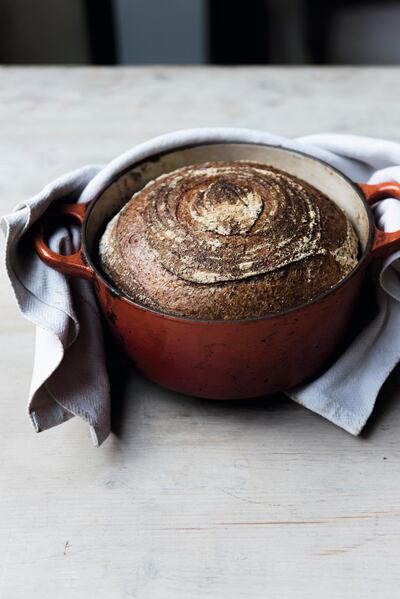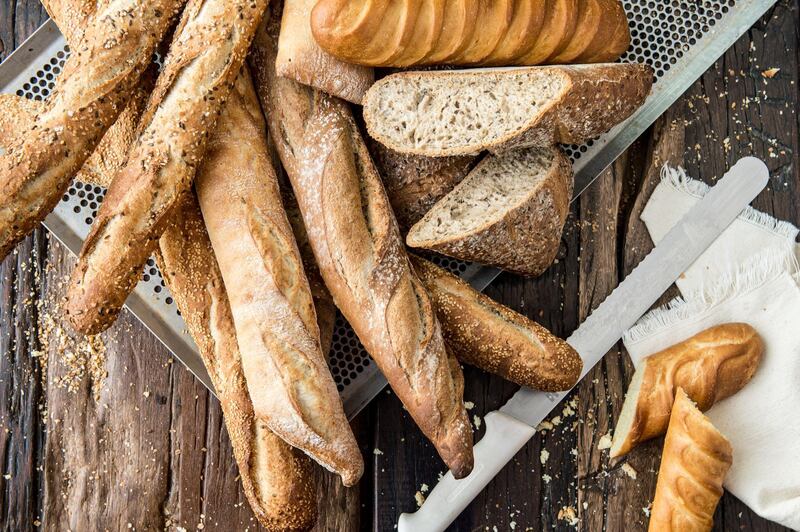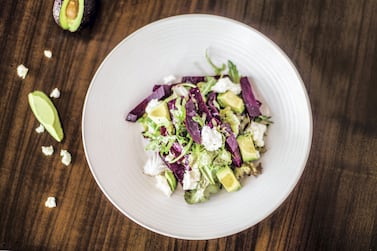With many of us staying at home in a bid to stem the spread of the coronavirus, we've got a little more time than usual to perfect our baking skills.
So, instead of nipping out to the supermarket to pick up a fresh loaf of bread, why not try making your own?
Pascal Tepper, the French bakery at Dubai's Four Points by Delta, Sheikh Zayed Road, shares two easy recipes that will work for both baking novices and pros alike.
Or, if you're a sourdough fan, scroll down below for a no-knead recipe.
Recipe: Traditional loaf (Pain de tradition)
Makes 2 loaves
Ingredients
900g traditional flour
100g stoneground flour
20g salt
100g liquid leaven (optional)
20g yeast
Equipment
Dough kneading machine
Oven
Method
Place the two flours, salt, water and leaven in a mixer bowl.
Mix the dough, adding the yeast.
Knead for six minutes at a low speed and eight minutes at setting two.
After the first rising (which takes about an hour), cut the dough into chunks of approximately 180g and rest for about 15 minutes before shaping each in the style you want.
After the second rising (which takes another hour), cook in a 250°C oven for about 40 minutes until the crust is golden.
Recipe 2: Traditional cereal bread (Pain de tradition aux cereales)
Makes 2 loaves
Ingredients
1kg traditional flour
20g salt
15g yeast
200g fermented dough
100g cereal grains
720g water
Equipment
Dough kneading machine
Oven
Method
Place the flour, water, salt in a mixing bowl and combine.
Add the yeast, then knead for five minutes at a low speed and six minutes at speed two with your machine.
During the last two minutes of kneading, mix in the fermented dough and half the cereal grains.
After the first rising (in 90 minutes), stretch the dough for a minute or so.
Rest for 15 minutes, then shape and sprinkle the remaining cereal grains on top of the loaf.
After the second rising (which takes about an hour), cook in a 250°C oven for about 40 minutes until the crust is golden.
If it’s sourdough – and a longer project – you’re hankering for, here’s a recipe from Baking School: The Bread Ahead Cookbook (Penguin Fig Tree).
Recipe: No-knead sourdough
Makes a 1kg loaf

Ingredients for the rye starter
Day 1
50g wholegrain rye flour
50ml cold water
Days 2, 3, 4 and 5
1 tbsp wholegrain rye flour
500g strong white bread flour, plus extra for dusting
150g rye starter
350ml water
11g fine sea salt
Semolina, for dusting
Equipment
Dutch oven (cast-iron casserole) or a baking stone
Water spray
Baker’s peel or a wooden board
Method for rye starter
On day one, just mix the flour together with cold water. Cover the mixture with a tea towel and leave at room temperature for 24 hours.
On each consecutive day, add one tablespoon of flour and one tablespoon of cold water to your existing starter, and mix together. By day five, the flour should be nice and lively, with some bubbling.
Method for no-knead sourdough
Day 1
Place the flour in a large mixing bowl. In another bowl, add the starter to the water and mix (your starter should float in the water). Make a well in the centre of the flour and pour in the liquid.
Use your hand like a fork to gently bring the dough together (don’t overmix — at this stage, you just want to combine until the flour has cleared). Cover and leave at room temperature for 1 hour.In this recipe, we use the delayed salt method. This gives your starter time to become active and your flour time to absorb water before the salt is added.
After an hour, uncover your dough and place the salt on top. Sprinkle a little water over the salt, then gently start pulling the salt through the dough. This should take about 30 seconds, at which point you should feel your dough start to tighten up slightly. Cover your dough and place in the fridge for 12 to 24 hours.
Day 2
Take your dough from the fridge and uncover. It will be a lot firmer now and will be starting to resemble a fully mixed dough.
You now need to give your dough a fold. This will start to develop the gluten, reactivate the yeast and put air pockets into the dough. Rest it for 30 minutes, then give it another fold. Rest for another half-hour, then take your dough out of the bowl and give it a gentle pre-shape. Cover and leave for 10 minutes.
Heavily dust your proving basket with flour, then shape your dough into a nice, tight round by bringing the outside edges of your hands together (with the palms facing up) underneath the loaf as you turn it on your work surface. This will create good tension in the loaf.
Place it upside down in the proving basket and leave for 1 hour at room temperature. Cover and place in the fridge for another 8 to 12 hours.
Day 3
Take your dough out of the fridge and leave it to rise for about 2 hours.
Preheat your oven to 250°C/fan 230°C/gas 10, or as hot as it will go.
Once your oven is ready, put a Dutch oven (cast-iron casserole) or baking stone in to heat up. Get your water spray ready if you are using a baking stone.
If you’re using a Dutch oven, very carefully take it out of the oven. Sprinkle the loaf with semolina and gently place top-down in the Dutch oven. Using a razor blade, cut two slashes in the dough.
Put the lid on, place in the oven and bake for 35 minutes, then remove the lid and bake for a further 25 minutes.
Take the Dutch oven out and very carefully remove the loaf, then put it back into the oven, directly on the oven shelf, and bake for a further 10 minutes, depending on how much singe you like.
If you’re using a baking stone, gently and slowly turn out your loaf on to a baker’s peel or a wooden board.
Using a sharp knife or a razor blade, cut two slashes on the top of the loaf, then slide the peel on to the baking stone in the oven.
Heavily spray inside the oven with your water spray, and bake for 30 minutes, then turn the loaf around and bake for a further 25 minutes, depending on how much singe you like.
Once completely baked, place the bread on a rack to cool before serving.









